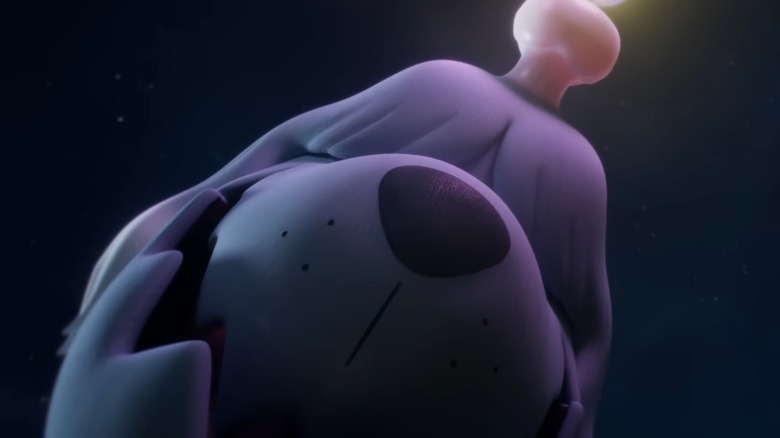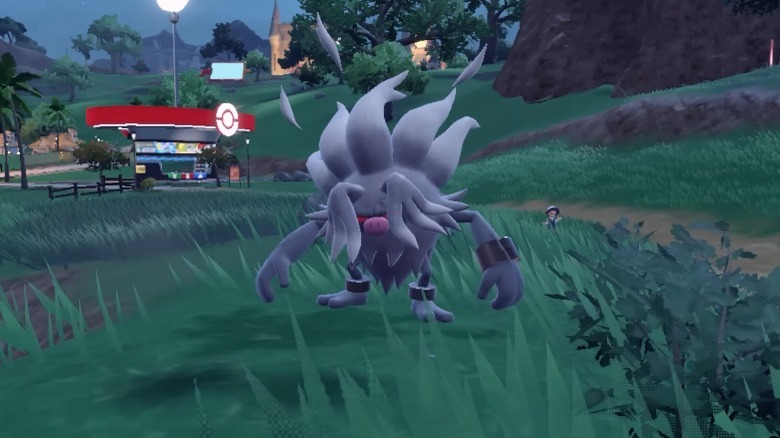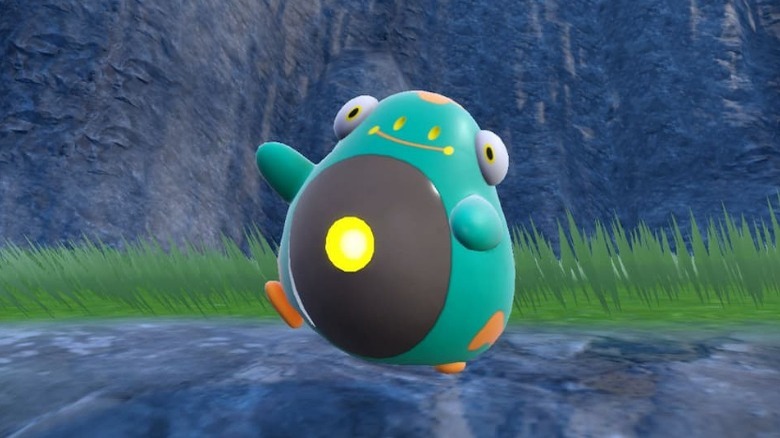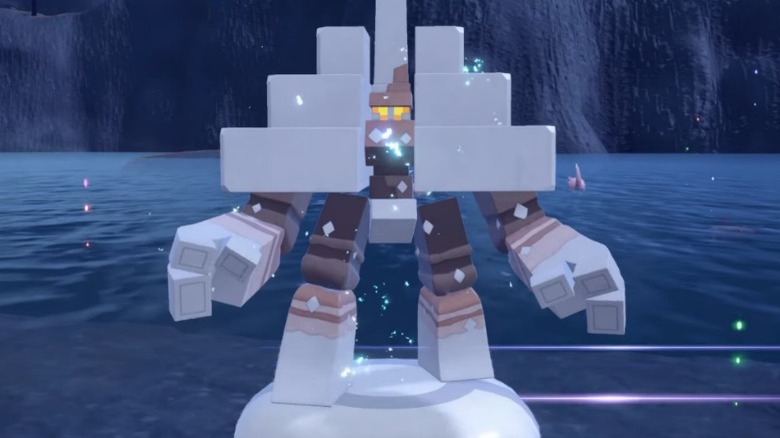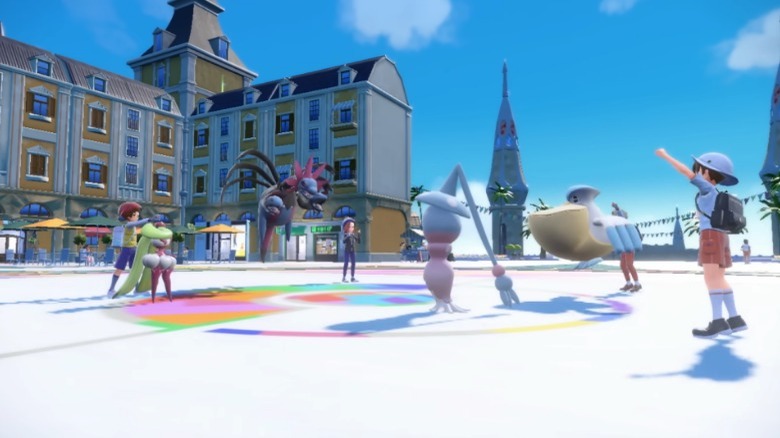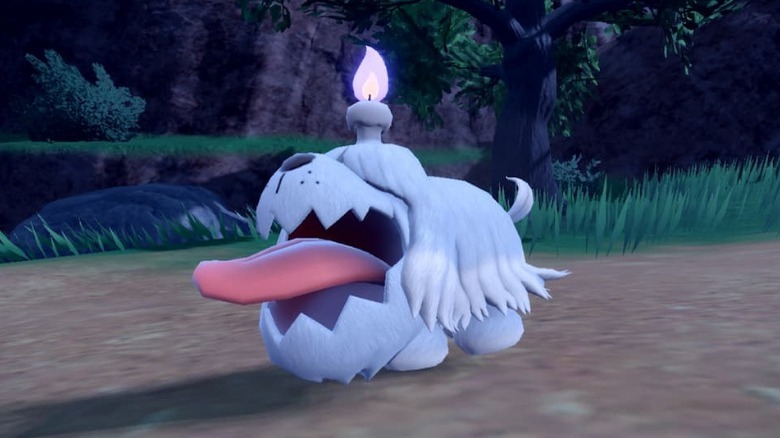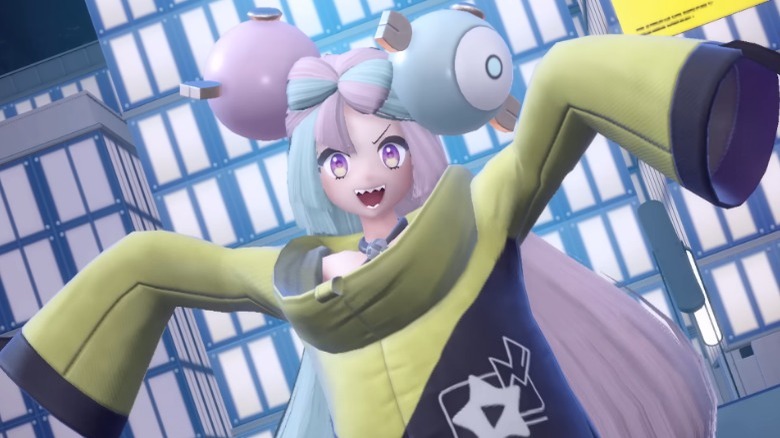Things Only Adults Notice In Pokémon Scarlet And Violet
The "Pokémon" franchise has been going strong for nearly three decades. While the series has never strayed far (if at all) from its child-friendly roots, the developers have realized that people of all ages play their games. So, sometimes coders, artists, and even localizers hide little nuggets that fly over the heads of children.
The latest entries in the "Pokémon" series, "Pokémon Scarlet and Violet," carry on the proud tradition of inserting small details young audiences will likely never understand or even recognize. No, not Easter eggs such as decorating a city with overworld and party Pokémon sprites from "Red Version" and "Blue Version;" that's a cute callback, but most gamers would understand the reference regardless of age. We're talking about Pokédex entries that deal with heavy subjects and designs that reference (or at least bear coincidental similarities to) titles too mature for younger gamers.
"Scarlet" and "Violet" might not hide anything as provocative as a bikini-clad trainer cheekily implying where she hides her Pokéballs, but the entries still feature plenty of aspects audiences might not get unless they are over 18.
Death isn't the end for Primeape
Mankey and its evolution Primeape are probably the saddest Pokémon in the series. Not literally sad, but that isn't far off; they are pitiable because they are always angry. Granted, this fury is a source of power for the primate-like puffballs, but it is also a potential burden — one that grants them even more strength in "Pokémon Scarlet and Violet."
As with previous mainline entries, "Scarlet" and "Violet" introduced a slew of new attacks, one of which is Rage Fist. This move powers up the more its user is hit, and only Primeape can learn it. Moreover, Primeape gained a new evolution, Annihilape, which is tied to Rage Fist. Primeape can't evolve unless it levels up after using Rage Fist 20 times. On one hand, this development gives the Pokémon some much-needed attention. On the other hand, it seems to kill Primeape.
According to the Pokédex in "Pokemon Sun," Primeape can become so angry it just up and dies. Given Rage Fist's description and mechanics, it's easy to connect the dots and guess that the angrier Primeape gets, the stronger it becomes. The Pokémon may die once it crosses the anger threshold, only to resurrect as a fighting zombie. Annihilape is part Ghost-type, and its "Scarlet" Pokédex entry states that the Pokémon gained new power when its anger crossed a "critical point." In some ghost stories, spirits are created out of sheer anger. The same appears to apply to Annihilape in "Pokémon Scarlet and Violet."
What do Pokémon and Dark Souls have in common?
"Pokémon" has been around long enough for Game Freak to draw inspiration from almost every corner of the animal kingdom — and beyond. Of course, other studios have also drawn from the same pool to create games that the younger "Pokémon" target demographic can't play just yet.
Two of the new Pokémon in "Pokémon Scarlet and Violet" are Tadbulb and its evolution Bellibolt. These Electric-type creatures are based on tadpoles and frogs (which is old hat for the franchise). But, aside from its type, its eyes are what set Bellibolt apart. No, not its real eyes; its fake eyes. Bellibolt features two large bumps on the side of its head that resemble eyes, while its real eyes are tiny yellow dots above its mouth. These bumps are reminiscent of real world animals that use eyespots to deceive would-be predators, such as the Cuyaba dwarf frog, but older gamers may recognize this specific mimicry pattern from another game.
In the "Dark Souls" series, few monsters are as reviled as the Basilisk. These creatures are infamous for their ability to cause instant death via a cloud of concentrated Curse, and they are immediately recognizable by their frog-like appearance and giant, bulbous eyes. Except those aren't eyes; they're giant bumps that only resemble eyes. The Basilisk's real eyes are tiny yellow dots above the mouth. Sound familiar? It should, because that's literally the same design as Bellibolt. Sure, Bellibolt isn't a Poison-type and it waddles around instead of hopping, but it channels the same animal mimicry trope as the "Dark Souls" Basilisk.
Is Garganacl hurting Pokémon?
Pokédex entries tend to hide many disturbing details. Did you know Mega Houndoom is so hot that its body is melting, or that Sliggoo is blind and tends to dissolve its own friends, thinking they're food? You probably wouldn't if you ignored the Pokédex, but it's not often that you find Pokédex entries that might be lying to your face.
The entire Nacli line, which was introduced in "Pokémon Scarlet and Violet," is one big reference to salt. Nacli and its evolutions, Naclstack and Garganacl, are based on rock salt. Their signature ability is Purifying Salt, which protects them from status conditions and Ghost-type moves, and they are the only Pokémon that can learn the damage-over-time attack Salt Cure. Even their names reference the chemical formula for salt, NaCl. So far, so factual, at least until you examine Garganacl's Pokédex entry.
According to "Pokémon Scarlet," Garganacl can heal injured Pokémon by sprinkling salt on them. While the Nacli line can learn plenty of defensive moves, they can't learn any support skills that heal allied Pokémon. And no, Recover doesn't count. However, Garganacl can learn Salt Cure, which lets them toss salt over a target ala Garganacl's Pokédex entry, but the move damages them instead of curing them. Except that's exactly what "curing" is: when you cure meat for preservation. So, despite the Pokédex saying otherwise, Garganacl isn't healing Pokemon by literally rubbing salt in their wounds, it's, um, figuratively rubbing salt in their wounds by doing so literally.
The Pokérus Vaccine
The "Pokémon" franchise has plenty of hidden mechanics most gamers will never use, let alone encounter. One example is the Pokérus. For those who have never heard of it, it is a very rare status effect that has been around since Gen 2. The Pokérus, short for "Pokémon Virus," doubles the effort values (EV) Pokémon gain after battle, which affects the stats they receive when leveling up. As its name suggests, the Pokérus is highly contagious, and any Pokémon that fight wild Pokémon with the Pokérus get infected, and it will spread to other Pokémon in the player's party.
Since the odds of encountering the Pokérus are 1 in 21,845, gamers can go through numerous playthroughs without ever acquiring it. Apparently, the developers at Game Freak asked themselves why they should bother placing such a rare mechanic in the game if few people will ever get to use it. As an answer, they seemingly just got rid of it. Twitter user @mattyhourkhana_ claimed that they dove into the game code of "Pokémon Scarlet and "Violet" and discovered these entries don't have any assets or code for the Pokérus — not even status icons. @mattyhourkhana_ even tried forcibly injecting the Pokérus into "Scarlet and Violet," but infected Pokémon received the normal amount of EV per battle and couldn't even spread the digital disease.
Since players are more likely to catch a shiny Pokémon than they are to contract the Pokérus, odds are no one would have noticed that Game Freak removed the Pokérus if someone hadn't hacked into the game and checked.
The lonely, unintentional killer
"Pokémon Scarlet and Violet" sport many dog-themed creatures. There's the bread-like Fidough, the ironically cute Maschiff, and Greavard, the most dangerous of this first-stage lot. Sure, Maschiff and Fidough have better stats, but unlike the others, Greavard drains the life of anyone near it. This deadly fact is corroborated by the poulterpup's dedicated trailer and the "Pokémon Scarlet and Violet" website. But wouldn't surviving be as easy as running away? Never underestimate the power of loneliness.
While none of Greavard's Pokédex entries mention its ability to siphon life energy, its "Violet" entry states the creature is so lonely that it will follow anyone who gives it the slightest attention. So, even if people run away from Greavard to escape its vampiric aura, it will still chase after them, eventually catch up, inadvertently kill them, and then restart this cycle all over again when someone else inevitably notices the lonely Greavard. Makes you wonder just how many Pokémon researchers lost their lives studying this creature before they realized they should let dead dogs lie. Given the number of Twitter users who have said they would gladly die for Greavard, this Pokémon probably has its own dedicated cemetery.
Iono's generous fan
The "Pokémon" franchise evolves with the times. When smartphones became staples of modern society, Game Freak gave each trainer a Rotom-powered phone. Since streaming is so popular, the company implemented the franchise's first streamer Gym Leader, Iono, in "Pokémon Scarlet and "Violet." Game Freak also decided to feature one of the more controversial sides of streaming.
When Nintendo and Game Freak introduced audiences to Iono, they gave her a streaming-style trailer. This video set up Iono's personality and tendency to interact with viewers — as any good streamer should — and this behavior continued into the games proper, albeit with less voice acting. Her pre-battle cutscene is full of off-screen viewers tuning in for the battle, most of whom just comment, but one, "Electro King," gifts Iono 5,000 Pokémon Dollars; she thanks them but otherwise brushes them off.
Audiences who have been around the streaming block may interpret this act as an example of what is colloquially called "simping." Though the meaning of the word has come under debate, it has been used to denote people (often males) who dote on streamers (or anyone else) with gifts and attention. Many view the term "simping" as an insult, and popular streamers such as Pokimane have even called it a misogynistic term. Whether or not you agree with her, though, it's possible to connect the dots between the perceived practice of simping and Electro King's actions.
A school for all ages
The "Pokémon" series relies on suspension of disbelief. Gamers should just accept that children between the ages of 11 and 16 are allowed to travel the world unsupervised and capture legions of superpowered animals. Are there even schools in the "Pokémon" universe? Yes, but not the way we know them. When players set out on their journey in "Pokémon Scarlet and Violet," in a series first, they begin in a school, although all classes are related to Pokémon. Understandable since every region in the series has caught a permanent case of Pokémon fever. When players attend classes, they are mostly paired up with students around the protagonist's age, but then gamers start exploring Paldea and battling other trainers.
As with prior entries, "Scarlet and Violet" let players challenge different trainer classes, one of which is the "Student" class. At first, these are an evolution of the "School Kid," which are invariably young children, but then you notice that Students come in a wide variety of ages. Some look like they could be students ... at a high school or college. Others look old enough to be going through a midlife crisis or living in a retirement home. Some are young enough to be in first grade, yet all of them are considered "Students." Clearly the curriculum of Paldea's premier school is geared towards anyone who wants to learn more about Pokémon, but it's still weird seeing children who need booster seats study and train alongside adults who are one year away from developing liver spots.
Everyone's tougher in Paldea
Training Pokémon is good exercise that offers plenty of fresh air, chucking balls at moving targets, and the occasional 100-meter dash away from an angry predator. Generally, Pokémon trainers are relatively fit, but some take this further than others. Hikers are one of the more common Trainer classes in the "Pokémon" franchise, as they have appeared in virtually every entry. While Hikers started as rotund, bearded men, they have become more fit as of late. Plus, players can even fight female Hikers in "Pokémon Scarlet and Violet," although they are a little more buff than usual.
Not only are female Hikers larger than most female NPCs in "Scarlet and Violet" (and most male NPCs), but the developers decided to put these Trainers in clothing that stretches tightly over their large frames. And more than a few female non-Trainer NPCs share this body type. Why the franchise's sudden interest in female bodybuilders? While it's impossible to say for sure, someone at Game Freak may have seen the female Worker Trainer in "Pokémon Sword and Shield," specifically the one that says, "The muscles I use for work and for battle are different," and decided to give female NPCs actual muscles in the next "Pokémon" games.
Tinkatink Is a Pokémon-ster hunter
Many Pokémon are predatory by nature. Sure, players can feed them curry, sandwiches, and berries, but look at the jaws of an Aerodactyl. Those serrated teeth weren't made for tearing up ferns. But when it comes to the world of Pokémon, eating the creatures a Pokémon hunts is a kindness, one that isn't shared by the franchise's latest Fairy/Steel-type.
Fairly early into "Pokémon Scarlet and Violet," players can catch Tinkatink, a diminutive pink Pokémon that carries around a rattle-like metal hammer. This Pokémon eventually evolves into Tinkatuff and finally Tinkaton, each with sequentially larger hammers. In fact, Tinkaton's oversized mallet is almost eight times as heavy as the Pokémon itself. Where do these miniscule blacksmiths get all the raw material? Fellow Steel-type Pokémon.
While Tinkatink starts by pounding iron scraps to create its first hammer, "Pokémon Scarlet" states that Tinkatuff forge their weapons out of metal gathered from Pawniard and Bisharp, as in Tinkatuff hunts these Pokémon, kills them, and smelts their bodies down into hammer components. Tinkaton create their mallets the same way except in bulk. According to various "Scarlet" Pokédex entries, they knock Corviknight out of the sky and use the remains to craft their oversized weapons. Tinkatink and its evolutions are the closest "Pokémon" has ever gotten to channeling "Monster Hunter" — for now, at least.

